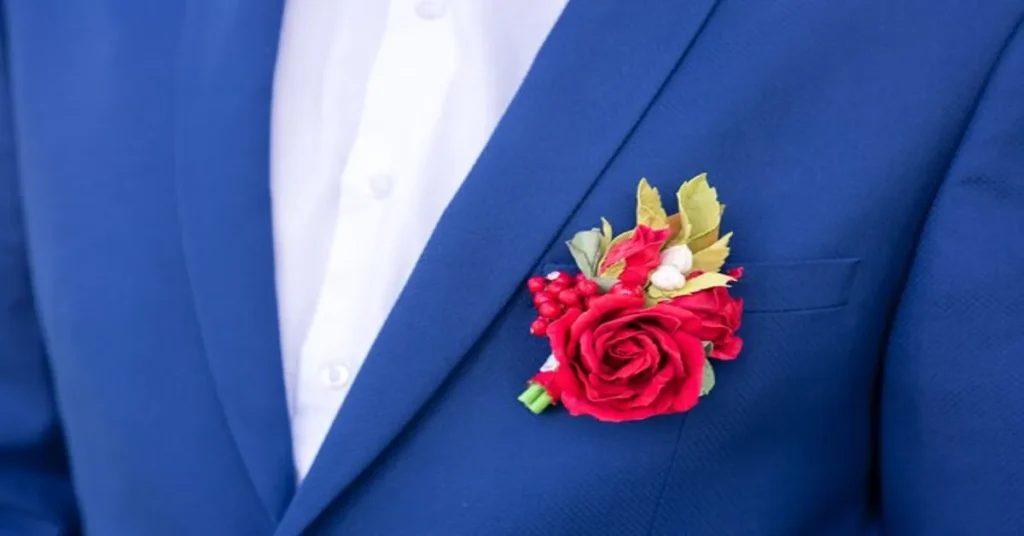A boutonniere is more than just a decorative accessory; it is a symbol of tradition, elegance, and style that has withstood the test of time. This small, yet meaningful piece of floral art is worn by men, most commonly at formal events such as weddings, proms, and other ceremonial occasions. The boutonniere is typically pinned to the lapel of a suit or tuxedo and adds a touch of sophistication to the wearer’s outfit. While its function may seem simple, the boutonniere carries a rich history and holds significant meaning, particularly in cultural and social contexts.
In this article, we will explore the history of the boutonniere’s, how it has evolved over the years, its role in modern fashion, and the symbolic meanings behind the flowers chosen for it. Whether you are preparing for a wedding, a special event, or simply curious about the significance of this elegant accessory, this guide will provide you with all the information you need to understand the boutonniere and its continued relevance in contemporary style.
The History of the Boutonniere
The word “boutonniere” comes from the French word “bouton,” which means “button,” referring to the small flower or decoration worn by men on their jackets, typically at the lapel. The boutonniere’s dates back to at least the 16th century, although the practice of wearing flowers on one’s clothing predates this. Originally, wearing flowers was believed to have practical uses, such as warding off bad odors, as hygiene practices were not as advanced as they are today.
In the Renaissance period, flowers were used to convey social status and rank. Wealthy individuals, including royalty and nobles, wore elaborate floral arrangements as a symbol of their prestige. During this period, the flowers in a boutonniere were also thought to have medicinal and protective properties, with each flower holding different symbolic meanings. For example, lavender was associated with cleanliness, while roses were seen as a symbol of love and passion.
The boutonniere as we know it today, however, emerged during the 19th century. It became more closely tied to formal events, such as weddings and balls. Over time, the boutonniere’s evolved from a symbolic gesture of protection to a fashionable accessory that added elegance and refinement to the wearer’s outfit.
Read: Mega-Personal.net Health Archives: Your Gateway to Comprehensive Health Archives
Symbolism Behind the Flowers in a Boutonniere
One of the most intriguing aspects of the boutonniere is the selection of flowers used. While any flower can technically be used, specific flowers carry particular meanings, and those meanings often influence the choice of flowers for the boutonniere. Understanding the symbolism of flowers can help individuals make more thoughtful decisions when choosing the flowers for their special event.
- Roses: The rose is perhaps the most iconic flower used in a boutonniere’s. Known for its beauty and fragrance, the rose symbolizes love, passion, and romance. It is a popular choice for weddings, particularly for the groom and groomsmen. The color of the rose also carries different meanings: red for love and respect, white for purity, and yellow for friendship and joy.
- Carnations: Carnations are another common flower in boutonnieres, particularly for formal events like weddings and proms. These flowers symbolize admiration, love, and distinction. They come in a wide range of colors, making them versatile for any occasion. Red carnations often represent deep love, while pink carnations symbolize gratitude and affection.
- Orchids: Orchids are a symbol of strength, beauty, and elegance. These exotic flowers are often chosen for their luxurious appearance and are perfect for events like high-end weddings. They can also represent rare beauty and are a popular choice for formal occasions, adding an air of sophistication to any boutonniere’s.
- Lilies: Lilies symbolize purity, renewal, and refined beauty. They are a common choice for weddings and are often paired with other flowers to create a harmonious and elegant bouquet. White lilies represent purity and new beginnings, while other colors like orange and pink convey a sense of warmth and appreciation.
- Lavender: Lavender is known for its calming and soothing qualities, and it represents devotion, calmness, and grace. It is often included in boutonnieres as a way to evoke a sense of tranquility and elegance. Lavender is a lovely choice for both weddings and other formal occasions, often paired with other flowers for a delicate, fragrant addition.
- Baby’s Breath: Baby’s breath, known for its delicate white blooms, is often used as an accent flower in boutonnieres. It symbolizes purity, everlasting love, and innocence. Baby’s breath is commonly included in boutonnieres for weddings and other romantic occasions, providing a soft contrast to larger, more vibrant flowers.
Boutonniere in Modern Fashion
While the boutonniere has its roots in tradition, it remains a key element of modern fashion, especially in formal events. In recent years, the boutonniere has become a versatile accessory, allowing for creativity and personal expression. Although it is most commonly worn by grooms at weddings, the boutonniere’s is also featured at proms, galas, and other elegant affairs.
In contemporary fashion, boutonnieres are often designed to complement the overall outfit. For instance, the groom’s boutonniere may match the bride’s bouquet or complement the color scheme of the wedding. Similarly, groomsmen often wear boutonnieres that match the bridal party’s attire, creating a cohesive look for the entire group. However, in some cases, individuals may opt for a more personalized boutonniere’s, choosing flowers that hold personal significance or reflect their unique style.
Boutonnieres are not only limited to floral designs. Some people incorporate non-traditional materials, such as feathers, ribbons, or fabric flowers, into their boutonnieres. These custom touches can add a modern or whimsical flair to the accessory, allowing individuals to break away from tradition while still embracing the spirit of the boutonniere’s.
How to Choose the Right Boutonniere
When selecting a boutonniere for a special occasion, there are several factors to consider to ensure that the accessory complements the outfit and the overall theme of the event.
- Event Type: The formality of the event should influence the style of the boutonniere’s. For formal events like weddings or galas, a classic floral boutonniere with elegant flowers such as roses or orchids is appropriate. For more casual or themed events, such as proms or parties, a boutonniere with a fun or unique design may be more fitting.
- Color Scheme: If you are attending an event like a wedding, it’s important to consider the color scheme. Many couples choose flowers that match their wedding colors, ensuring that the boutonniere’s complements the bride’s bouquet and the overall decor. Consider choosing flowers in similar hues or subtle contrasts to achieve a harmonious look.
- Personal Style: A boutonniere should reflect your personal style and taste. If you prefer traditional elegance, opt for classic flowers like roses or carnations. For a more modern or creative look, you might choose unique flowers or add unexpected elements like fabric flowers, pins, or vintage accents.
- Flowers’ Meaning: As mentioned, flowers carry different symbolic meanings. When selecting a boutonniere, think about the message you want to convey. For a wedding, you may want to choose flowers that symbolize love, commitment, and purity. For other events, such as a formal dinner or award ceremony, you may select flowers that represent admiration or respect.
- Size and Design: The size of the boutonniere is important for ensuring it complements the outfit without overpowering it. For instance, a groom’s boutonniere should not be too large, as it may detract from the rest of the attire. A smaller, more subtle boutonniere may be more appropriate for a sleek suit, while larger, bolder designs work well with more dramatic looks.
Read: Navigating Legal Options: Help You Find a Wyoming Mesothelioma Lawyer Vimeo
Caring for and Wearing a Boutonniere
To ensure that your boutonniere remains fresh and beautiful throughout the event, it is essential to handle it with care. Here are some tips for caring for and wearing a boutonniere:
- Keep it Cool: Floral boutonnieres should be stored in a cool place to prevent wilting. If you receive your boutonniere in advance, store it in the refrigerator to keep it fresh until the event.
- Watering: If possible, water the stems of the flowers in your boutonniere before wearing it. A quick dip in water will help keep the blooms hydrated.
- Pinning the Boutonniere: When pinning your boutonniere, make sure it is placed securely on the left lapel of your jacket, just above the heart. Use the provided pin to attach it carefully, making sure it is facing upward. The boutonniere should not be too tight against the fabric, allowing it to sit naturally.
Conclusion
The boutonniere is a timeless symbol of elegance, tradition, and personal expression. Whether worn at a wedding, a formal event, or a special occasion, the boutonniere continues to play a significant role in fashion, adding a touch of sophistication and charm to the wearer’s outfit. From its historical roots to its modern-day use, the boutonniere remains a beloved accessory that represents love, respect, and beauty.
Choosing the right boutonniere involves careful consideration of the event, the color scheme, and personal style. With the right flower, design, and care, a boutonniere can enhance any formal outfit and leave a lasting impression. Today, the boutonniere is more than just a flower; it’s a meaningful accessory that adds character and elegance to any occasion.
FAQs
- What is the meaning of a boutonniere? A boutonniere is a small flower or floral arrangement worn on the lapel, symbolizing elegance, love, and respect.
- Where do you wear a boutonniere? A boutonniere is typically worn on the left lapel of a suit or tuxedo, just above the heart.
- How do you make a boutonniere stay in place? The boutonniere is pinned to the lapel using a small pin, ensuring it stays in place throughout the event.
- Can you wear a boutonniere without a suit? While it’s traditionally worn with formal attire like a suit or tuxedo, a boutonniere can also be worn with casual or themed outfits for special occasions.
- How do you keep a boutonniere fresh? Store the boutonniere in a cool place and keep the stems hydrated before wearing it to ensure it remains fresh.
- What flowers are commonly used in a boutonniere? Popular flowers for boutonnieres include roses, carnations, orchids, lilies, and baby’s breath, each symbolizing different meanings.







